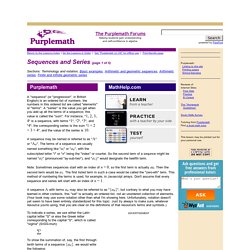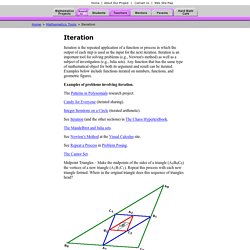

Sequences and Series: Terminology and Notation. Sequences and Series (page 1 of 5) Sections: Terminology and notation, Basic examples, Arithmetic and geometric sequences, Arithmetic series, Finite and infinite geometric series A "sequence" (or "progression", in British English) is an ordered list of numbers; the numbers in this ordered list are called "elements" or "terms".

A "series" is the value you get when you add up all the terms of a sequence; this value is called the "sum". For instance, "1, 2, 3, 4" is a sequence, with terms "1", "2", "3", and "4"; the corresponding series is the sum "1 + 2 + 3 + 4", and the value of the series is 10. A sequence may be named or referred to as "A" or "An". Note: Sometimes sequences start with an index of n = 0, so the first term is actually a0. A sequence A with terms an may also be referred to as "{an}", but contrary to what you may have learned in other contexts, this "set" is actually an ordered list, not an unordered collection of elements.
a1 + a2 + a3 + a4 + a5 + a6 + a7 + a8 + a9 + a10. Sequences. You can read a gentle introduction to Sequences in Common Number Patterns.

What is a Sequence? A Sequence is a list of things (usually numbers) that are in order. Infinite or Finite When the sequence goes on forever it is called an infinite sequence, otherwise it is a finite sequence Examples: {1, 2, 3, 4, ...} is a very simple sequence (and it is an infinite sequence) {20, 25, 30, 35, ...} is also an infinite sequence. Making Mathematics: Mathematics Tools: Iteration. Iteration is the repeated application of a function or process in which the output of each step is used as the input for the next iteration.

Iteration is an important tool for solving problems (e.g., Newton's method) as well as a subject of investigation (e.g., Julia sets). Any function that has the same type of mathematical object for both its argument and result can be iterated. Examples below include functions iterated on numbers, functions, and geometric figures. Examples of problems involving iteration. The Patterns in Polynomials research project.
Candy for Everyone (iterated sharing). Integer Iterations on a Circle (iterated arithmetic). See Iteration (and the other sections) in The Chaos Hypertextbook. The Mandelbrot and Julia sets. See Newton’s Method at the Visual Calculus site. See Repeat a Process in Problem Posing. The Cantor Set. Midpoint Triangles – Make the midpoints of the sides of a triangle (A0B0C0) the vertices of a new triangle (A1B1C1). Graph Theory. YAMAGUCHI, Jun-ichi In the sprign semester 2005, I take the mathematics course named "Graph Theory(MATH6690).

" This course is hard but very interesting and open my eyes to new mathematical world. I have loved study Graph theory and really want you to study this very young mathematics. This field of mathematics can be applied for many issues, rainging from operational research and chemistry to genetics and linguistics, and from electrical engineering and geography to sociology and architecture. What is Graph Theory? Graph theory concerns the relationship among lines and points. A graph consists of some points and some lines between them. No attention is paid to the position of points and the length of the lines. Thus, the two graphs below are the same graph. You can get more detailed information of graph theory at this site ( Basic Terms of Graph Theory a SIMPLE graph G is one satisfying that; (1)having at most one edge (line) between any two vertices (points) and, Combinations and Permutations.
What's the Difference?

In English we use the word "combination" loosely, without thinking if the order of things is important. In other words: So, in Mathematics we use more precise language: In other words: A Permutation is an ordered Combination. Permutations There are basically two types of permutation: Repetition is Allowed: such as the lock above. 1. These are the easiest to calculate. When we have n things to choose from ... we have n choices each time! When choosing r of them, the permutations are: n × n × ... (In other words, there are n possibilities for the first choice, THEN there are n possibilites for the second choice, and so on, multplying each time.) Which is easier to write down using an exponent of r: n × n × ...
Example: in the lock above, there are 10 numbers to choose from (0,1,...9) and we choose 3 of them: